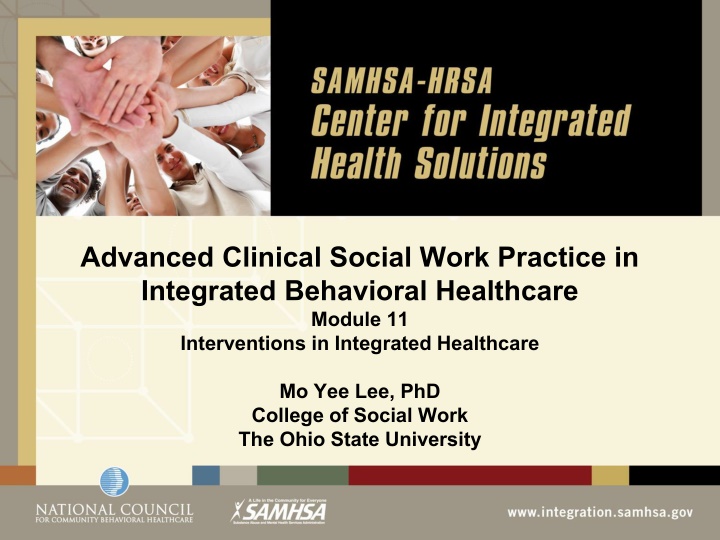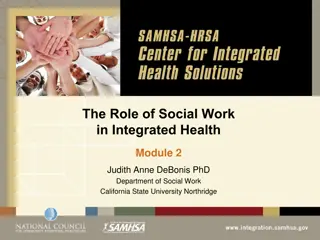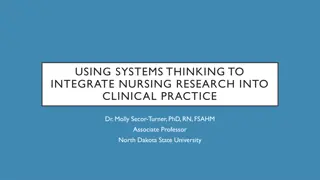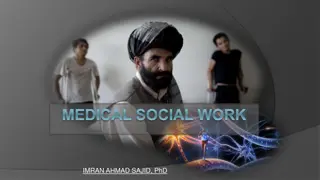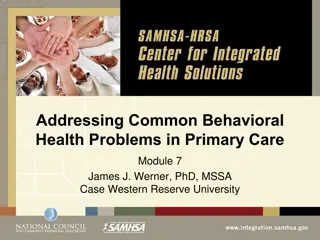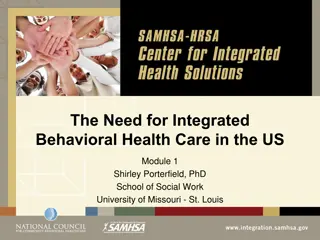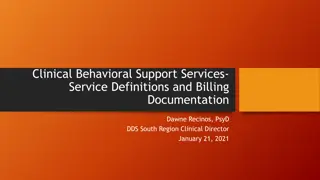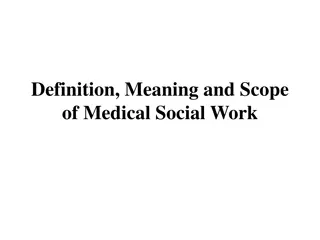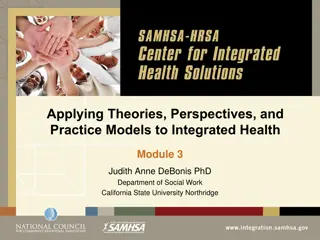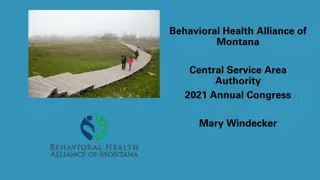Advanced Clinical Social Work Practice in Integrated Behavioral Healthcare
This module delves into various intervention models and principles in integrated healthcare, covering patient activation, behavioral activation, the IMPACT model, and SBIRT. It also highlights components of recovery and the concept of effective parsimony in brief interventions. Additionally, it discusses stepped care and patient-oriented care strategies.
Download Presentation

Please find below an Image/Link to download the presentation.
The content on the website is provided AS IS for your information and personal use only. It may not be sold, licensed, or shared on other websites without obtaining consent from the author.If you encounter any issues during the download, it is possible that the publisher has removed the file from their server.
You are allowed to download the files provided on this website for personal or commercial use, subject to the condition that they are used lawfully. All files are the property of their respective owners.
The content on the website is provided AS IS for your information and personal use only. It may not be sold, licensed, or shared on other websites without obtaining consent from the author.
E N D
Presentation Transcript
Advanced Clinical Social Work Practice in Integrated Behavioral Healthcare Module 11 Interventions in Integrated Healthcare Mo Yee Lee, PhD College of Social Work The Ohio State University
Module 11 Interventions in Integrated Health: Outline Develop knowledge of intervention models used in integrated health Brief intervention1 Patient Activation2 Behavioral Activation3 IMPACT model4 SBIRT model5 Develop knowledge of an overview of evidence-informed treatments Develop knowledge on the principles in adapting ESTs in integrated health Develop skills in a solution-focused approach to intervention
Components of Recovery6 Self-Direction Individualized and Person-Centered Empowerment Holistic Non-Linear Strengths-Based Peer Support Respect Responsibility Hope
Models in Integrated Health Brief Intervention Patient Activation Behavioral Activation IMPACT Model SBIRT
Brief Intervention7 Intervention principles based on Concept of Effective Parsimony : Least disruptive treatment for positive outcomes Least extensive treatment for positive outcomes Least intensive treatment for positive outcomes Least expensive treatment for positive outcomes Least expensive training of professionals to provide effective treatment
Brief Interventions: Stepped Care8 Intensity of treatment is based on problem severity and client s response: Minimal educational efforts and information sharing Psycho-educational interventions Provide illness/diagnoses-specific behavioral interventions If no improvement, refer to specialty mental health system
Patient Activation9 A patient-oriented care with patients and their families integrated as members of the care team: Collaborative definition of problems attending to both patient- defined and medical problems diagnosed by physicians Targeting, goal setting, and planning, in which patients and providers focus on a specific problem, set realistic objectives, and develop an action plan for attaining those objectives in the context of patient preferences and readiness Creation of a continuum of self-management training and support services, in which patients have access to services that teach skills needed to carry out medical regimens, guide health behavior changes, and provide emotional support Active and sustained follow-up, in which patients are contacted at specified intervals to monitor health status, identify potential complications, and check and reinforce progress in implementing the care plan.
Behavioral Activation10 Activating clients for targeted, desirable behaviors Monitor ongoing avoidance patterns
Behavioral activation techniques Scheduling behavioral activities Graded homework assignments In-session rehearsal and role playing of targeted behaviors Therapist modeling of targeted behaviors Managing situational contingencies to facilitate initiation and successful completion of targeted behavior more likely Problem solving to identify specific behavioral targets Training to overcome skills deficits that interfere with initiation and maintenance of targeted behaviors
Monitor Avoidance Behavior by ACTION11 Assess how this behavior serves you Choose either to avoid or activate Try out whatever behavior has been chosen Integrate any new behaviors into a routine Observe the outcome Never give up
Monitoring Avoidance: TRAP Vs TRAC Teach clients to identify TRAP Trigger Response Avoidance Pattern Replace by TRAC Trigger Response Alternate Coping behaviors
IMPACT Model12 Improving Mood-Promoting Access to Collaborative Treatment (IMPACT) Collaborative Care Model Onsite depression treatment in a primary care facility Stepped Treatment According to outcomes and evidence-based methods 50% symptom reduction in 10-12 weeks If no improvement, change in treatment plan
IMPACT Model Primary Care Provider Patient/ Client Behavioral Health Consultant Psychiatrist
IMPACT Model (Contd) Behavioral Health Consultant Depression education Medication therapy support Behavioral activation Brief counseling course Monitors symptoms and measures outcomes using a validated tool Relapse Prevention Primary Care provider Works with behavioral health consultant Consults psychiatrist if needed Designated psychiatrist Works with other two on patients who do not improve
SBIRT Model13 Screening, Brief Intervention, and Referral to Treatment (SBIRT) Substance abuse care model Easily used in primary care settings Attempts to screen for those who may not be seeking help
SBIRT Model Screening Find those at risk of substance abuse Use a quick 1-3 question screen Use a standardized risk assessment tool if screen is positive Brief Intervention Increase insight and awareness of substance abuse 5-30 min discussion regarding substance abuse Referral to Treatment Refer to specialized addiction treatments Assist patients with navigation of barriers Financial Transportation
Examples of Evidence-Informed Treatments Behavior therapy Cognitive-behavior therapy E.g. for treating trauma (Trauma-focused CBT), depression, anxiety Exposure therapy Brief dynamic psychotherapy Interpersonal therapy Solution-focused brief therapy Dialectical Behavioral therapy EMDR Emotional-focused therapy Family treatment approaches: Multisystemic (MST) Integrative Family and Systems Treatment (I-FAST) Brief Strategic Family Therapy Multi-dimensional Family Therapy
Principles for adapting ESTs for Primary Care14 Embrace the Primary Care philosophy Treat more people with less intensity Expand the population to be served Study/treat patients with other disorders (co-morbidity) sub-threshold symptoms alcohol and drug usage Plan for cultural, linguistic, and medical diversity
Principles for adapting ESTs for Primary Care15 Use a patient-centered approach Deliver services in multiple formats Individual, group, as well as telephone sessions Reduce treatment length and Intensity Use home materials and telephone consultation as well Convert to a Patient Education Model Help patients to manage symptoms through education
Principles for adapting ESTs for Primary Care15(Cont d) Adopt a Relapse Prevention Focus Protocols for detecting at-risk patients Schedule of booster contacts Team-based Intervention Physicians, nurses, etc. manage mental health alongside behavioral health providers Increased communication
FLAIR Model: Selecting interventions A process to select appropriate ESTs: Formulate an empirically relevant question answerable by data (e.g., Why do members of X racial group often drop out of treatment? ) Locate the best available evidence Assess the quality of the evidence Integrate the best available evidence with professional judgment, client factors, and social context Review how treatment went
A Solution-Focused Approach to Integrated Health
Resilience and Strengths Change is Constant Non-Problem state Exceptions Problem Strengths Resilience Goal of Treatment What is noticed becomes reality, and what is unnoticed does not exist16 Consumer s Construction
Power of Language Language and reality Reality is co-constructed through therapeutic conversation What is noticed becomes reality and what is unnoticed does not exist17 Pre-suppositional language: Expectation of change Social construction Problem and solution as client s construction
Constructing useful questions Constructing useful evaluative questions: Self-initiated feedback if it is your idea, it is not their idea Empowerment Initiate a process of self-assessment
Self-evaluative Questions for Initiating Change18 Exploring questions Difference questions Planning questions Effect questions Indicator questions Exception questions Outcome questions
Self-Evaluative Questions for Initiating Change19 Helpfulness questions Feasibility questions Resilience/Coping questions Meaning questions Past successes Relationship questions Scaling questions
Identifying exceptions to initiate the change process: The Miracle Question20 Suppose that after our meeting today, you go home, do your things and go to bed. While you are sleeping, a miracle happens and the problem that brought you here is suddenly solved, like magic. The problem is gone. Because you were sleeping, you don t know that a miracle happened, but when you wake up tomorrow morning, you will be different. How will you know a miracle has happened? What will be the first small sign that tells you that the problem is resolved? How will your spouse, you child (any significant others) know that something is different? What do you think have to be different for the miracle to start happening? Are there times when that already happen a little bit? How come? What's different? What will have to happen for that to happen more often?
Treatment process that builds exceptions and creates change Notice Elicit Amplify Reinforce Remember and consolidate The devil is in the details
Deciding when to focus on exceptions Patients/clients are able to identify exceptions and the professional is able to help them develop useful treatment directions and goals based on this line of therapeutic dialogue The professional observes that patients/clients are energized by these questioning sequences and becomes more hopeful and engaged in treatment A process of change is triggered by this line of therapeutic dialogues as evident by positive, specific, and behavioral changes in the problem pattern
Identifying exceptions and use of language21 Do use language that implies the patient/client wants to change implies that the patient/client is capable of change implies change has occurred or is occurring implies that the changes are meaningful encourages the patient/client to explore possibilities for change suggests that the patient/client can be creative and playful about life. conveys recognition of the families evolution of their personal story. Limit energy expended in unproductive areas such as negative, blaming, self-defeating descriptions
Solution-Focused Tasks Out-of-session tasks that allows people to further explore solutions Do more of what works Observation Tasks Do Something Different Pretending task Solution Focused tasks suggest change has already occurred but has gone unrecognized. Tasks are then arranged around looking for evidence of change (looking for exceptions).
Utilizing Strengths and The Use of Tasks There is no failure, just experimentation Make use of whatever response the patient/client gives to a task Professional suggests ideas for the task, but patients/clients must ultimately decide on a task for themselves
Noticing and amplifying positive changes: Go for DETAILS What s better How questions How are you able to do that? How did you make this happen? What questions What have you done to make this happen? Difference questions Effect questions Relationship questions Scaling questions Compliment change efforts
Tracking Change: Self-Evaluative Questions for Consolidating and Sustaining Change22 Connection questions: The mechanism of change Choice questions: Personal agency Comparison questions: Knowing the difference Meaning questions Ownership questions: Personal agency Relationship questions Scaling questions Compliments: Motivation and hope
Give Patient/Client Credit The patient/client must understand change as coming from his or her actions Make comprehensive lists of what the patient/client did to create change
Indicators of the presence of Black Holes Blaming talk Repetition of ideas that amplify or maintain the problem patterns An individual working much harder than another with no apparent benefit, particularly if this person is the therapist Decreased energy of the patients/clients involved and/or service providers
How to Respond to black holes Stop whatever you are doing Consider doing something different Engage in the opposite of what you are currently doing, therefore, redirecting energy to other potentially beneficial activities that have been neglected
Principles of solution-focused therapy23 If it works, don't fix it. Do more of it. If it doesn't work, do something different--even if it seems illogical or crazy. There is no failure, only feedback
Case Discussion Maria is a 32-year-old Latino female who is currently living with her husband (Jay, M/32) and her 2-year-old son, Kurt. Maria was diagnosed with breast cancer three months after she gave birth to Kurt, which took the whole family in shock. Maria went through chemo and drug treatment and now is considered recovered. However, Maria continues experiencing frequent headaches and sleepless nights, which seems to get worse recently. Maria shares with her doctor that she constantly feels anxious, worry, and unsettled during the recent follow-up check up. Maria and Jay have a supportive relationship and Jay has a stable, well-paid job as a computer engineer. Maria has a close relationship with her mother and 2 sisters although she does not have an active social life and spends most of her time at home.
Discussion questions Who would you collaborate in the treatment process (including both family members and professionals)? What are the factors that will need to be considered in treatment? What is the presenting problem and from whom s perspectives? What is the identified problem pattern and what are the exceptions to the problem? How would you help Maria and the family to develop a useful and attainable goal for treatment? Suppose you are using SFBT, what would be some helpful intervention steps and procedures? Pick an integrated healthcare intervention model and propose some potential helpful intervention steps and procedures.
References 1. Munger & Curtis. (2012) Brief treatment: A model for clinical guidelines to integrated care. in Curtis, R. & Christian, E. Integrated care: Applying theory to practice. New York: Taylor & Francis. 2. Von Korff, M., Gruman, J., Schaefer, J., Curry, S. J., & Wagner, E. H. (1997). Collaborative management of chronic illness. Annals of Internal Medicine, 127 (12), 1097-1102. 3. Martell, C. R., Addis, M. E., & Jacobson, N. S. (2001). Depression in context: Strategies for guided action. New York: W. W. Norton. 4. Mauer, B. J. (April 2009). Behavioral Health/primary care integration and the person-centered healthcare home. Washington, DC: National Council for community Behavioral Healthcare. 5. Madras, B. K., Compton, W. M., Avula, D. et al., (2009). Screening, brief interventions, referral to treatment (SBIRT) for illicit drug and alcohol use at multiple healthcare sites: Comparison at intake and six months later. Drug and Alcohol Dependence, 99, 280-295. 6. SAMHSA (Feb 2006). National consensus statement on mental health recovery. SAMHSA, CMHS. 7. Munger & Curtis. (2012) Brief treatment: A model for clinical guidelines to integrated care. in Curtis, R. & Christian, E. Integrated care: Applying theory to practice. New York: Taylor & Francis. 8. Munger & Curtis. (2012) Brief treatment: A model for clinical guidelines to integrated care. in Curtis, R. & Christian, E. Integrated care: Applying theory to practice. New York: Taylor & Francis. 9. Von Korff, M., Gruman, J., Schaefer, J., Curry, S. J., & Wagner, E. H. (1997). Collaborative management of chronic illness. Annals of Internal Medicine, 127 (12), 1097-1102.
References (Contd) 10. Martell, C. R., Addis, M. E., & Jacobson, N. S. (2001). Depression in context: Strategies for guided action. New York: W. W. Norton. 11. Martell, C. R., Addis, M. E., & Jacobson, N. S. (2001). Depression in context: Strategies for guided action. New York: W. W. Norton. 12. Mauer, B. J. (April 2009). Behavioral Health/primary care integration and the person-centered healthcare home. Washington, DC: National Council for community Behavioral Healthcare. 13. Madras, B. K., Compton, W. M., Avula, D. et al., (2009). Screening, brief interventions, referral to treatment (SBIRT) for illicit drug and alcohol use at multiple healthcare sites: Comparison at intake and six months later. Drug and Alcohol Dependence, 99, 280-295. 14. O Donohoe, W., Cummings, N., Byrd, M., & Henderson, D. (Eds.) (In Press). Behavioral integrative care: Treatments that work in the primary care setting. New York: Brunner- Routledge. 15. O Donohoe, W., Cummings, N., Byrd, M., & Henderson, D. (Eds.) (In Press). Behavioral integrative care: Treatments that work in the primary care setting. New York: Brunner- Routledge. 16. Lee, M. Y., Sebold, J., Uken, A. (2003). Solution-focused treatment with domestic violence offenders: Accountability for change. New York: Oxford University Press. 17. Lee, M. Y., Sebold, J., Uken, A. (2003). Solution-focused treatment with domestic violence offenders: Accountability for change. New York: Oxford University Press. 18. Lee, M. Y., Sebold, J., Uken, A. (2003). Solution-focused treatment with domestic violence offenders: Accountability for change. New York: Oxford University Press.
References (Contd - 2) 19. Lee, M. Y., Sebold, J., Uken, A. (2003). Solution-focused treatment with domestic violence offenders: Accountability for change. New York: Oxford University Press. 20. Berg, I. K. & Miller, S.D. (1992). Working with the problem drinker: A solution-focused approach. New York: W.W. Norton & Co. 21. Lee, M. Y., Sebold, J., Uken, A. (2003). Solution-focused treatment with domestic violence offenders: Accountability for change. New York: Oxford University Press. 22. Lee, M. Y., Sebold, J., Uken, A. (2003). Solution-focused treatment with domestic violence offenders: Accountability for change. New York: Oxford University Press. 23. de Shazer, S. (1988). Clues: Investigating solutions in brief therapy. New York: W. W. Norton.
